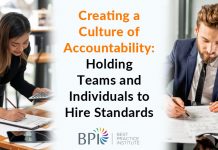Employees who feel deeply connected their work tend to perform at a higher level (see Meyer & Allen, 1991; Schaufeli & Bakker, 2004). Similarly, organizations that employ a large percentage of employees who feel a sense of connection with their companies perform at a higher level (see Angle & Perry, 1981; Saks, 2006). This makes inherent sense to the average person – of course employees who are committed to their organizations will work harder and better, and of course these organizations will receive the benefits of dedicated employees. However, there still exists a need to determine the organizational qualities that create employees who feel a profound sense of connection with the companies they work for. To fill this need and to develop both empirical and practical understanding of the relationship between employees and the companies they work for, Best Practice Institute (BPI) conducted research to answer the following questions:
What do we mean when we say employees love their workplaces?
How do Most Loved Workplaces ensure organizations perform at a higher level?
How can companies foster employees who love their companies?
The following describes these questions and our progress in more detail:
What do we mean when we say employees love their workplaces?
We made powerful gains in identifying and describing engaged employees with its Most Loved Workplace measure. The research focused on the strongest possible connection between employees and their jobs – it measured the degree to which employees love their job. Think of the co-worker who shows up early, who always has the answers, who feels committed towards their work and their teams. This person loves their job, and a primary goal of best-practice organizations is to employ as many of these individuals as possible.
How do Most Loved Workplaces ensure organizations perform at a higher level?
To answer the second question, we surveyed over 150 employees from Fortune 1000 companies. Employees who work in a most loved environment reported themselves as being 94% more likely to perform at a higher level, with 59% saying they are four times more likely to submit superior performance. Employees in Most Loved Workplaces also reported stronger group cohesion, reduced turnover intentions, and 41% reported a willingness to recommend their company to a friend.
How can companies foster employees who love their companies?
We used qualitative analysis techniques to identify aspects of organizations where employees felt especially connected to their work and their company, interviewing members of high-functioning organizations about the aspects of their organizations that made them feel connected. Then, we coded the text of the employees’ responses to identify the most-critical aspects of a Most Loved Organization®. Six prominent themes emerged:
- Teamwork/Collaboration
- Honesty and Integrity
- Respect
- Effort
- Competence
- Communication
Companies that are considered a Most Loved Workplace ® exemplify these themes, which have all been shown to strongly predict both employee and organizational performance in empirical literature (e.g. Frazier et al. 2017; Lee & Ashton, 2004; Lee & Choi, 2003; Steven & Campion, 1994). The current work expands upon scientific understanding to identify these six qualities as the most critical components of a high-functioning organization. Companies that are performing at high levels are composed of employees who can communicate with one another in order to work together and accomplish group goals. They employ individuals with personalities predisposed to working hard and maintaining their integrity. Further, these companies create environments in which employees feel respected by those around them, and trust that their voice will be heard. In the current work these themes emerged as more powerful predictors of optimal organizational outcomes than did pay, or scheduling flexibility, or upwards mobility. In other words, they are prerequisites for employees who Love their Workplaces.
References
Angle, H. L., & Perry, J. L. (1981). An empirical assessment of organizational commitment and organizational effectiveness. Administrative science quarterly, 1-14.
Frazier, M. L., Fainshmidt, S., Klinger, R. L., Pezeshkan, A., & Vracheva, V. (2016). \ Psychological Safety: A Meta‐Analytic Review and Extension. Personnel Psychology.
Lee, K., & Ashton, M. C. (2004). Psychometric properties of the HEXACO personality inventory. Multivariate behavioral research, 39(2), 329-358.
Lee, H., & Choi, B. (2003). Knowledge management enablers, processes, and organizational performance: An integrative view and empirical examination. Journal of management information systems, 20(1), 179-228.
Meyer, J. P., & Allen, N. J. (1991). A three-component conceptualization of organizational commitment. Human resource management review, 1(1), 61-89.
Saks, A. M. (2006). Antecedents and consequences of employee engagement. Journal of managerial psychology, 21(7), 600-619.
Stevens, M. J., & Campion, M. A. (1994). The knowledge, skill, and ability requirements for teamwork: Implications for human resource management. Journal of management, 20(2), 503-530











Yes. I think teamwork should be at the top of the list. Employees could work without a need for pay once the contribution of everyone is considered important. Great read!